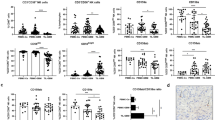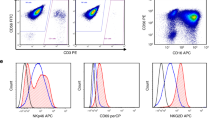Abstract
We report the natural killer (NK) and lymphokine activated killer (LAK) cell activities in peripheral blood lymphocytes (PBL) from untreated patients with Hodgkin's disease (HD) and from healthy donors. The frequency of LAK cell precursors was also studied using limiting dilution analysis (LDA). About 75% of the HD patients had normal NK activity. There was a higher percentage of low NK responders (mean percent NK activity of healthy donors--2 SD) in patients with lymphocyte depletion histologic grade of the disease and those who were in clinical stage IV, suggesting a correlation of decrease in NK activity with poor prognosis. We found efficient LAK activity against the NK-sensitive K562 cells and NK-resistant VIP (melanoma) and T-24 (bladder carcinoma) tumour targets in both low and normal NK responder HD patients, irrespective of the histopathological grade and clinical stage of the disease. In concordance with their good LAK cell activity, HD patients showed a frequency distribution of LAK cell progenitors in the PBL comparable to that of healthy donors.
This is a preview of subscription content, access via your institution
Access options
Subscribe to this journal
Receive 24 print issues and online access
$259.00 per year
only $10.79 per issue
Buy this article
- Purchase on Springer Link
- Instant access to full article PDF
Prices may be subject to local taxes which are calculated during checkout
Similar content being viewed by others
Author information
Authors and Affiliations
Rights and permissions
About this article
Cite this article
Rajaram, N., Tatake, R., Advani, S. et al. Natural killer and lymphokine activated killer cell functions in Hodgkin's disease. Br J Cancer 62, 205–208 (1990). https://doi.org/10.1038/bjc.1990.261
Issue Date:
DOI: https://doi.org/10.1038/bjc.1990.261
This article is cited by
-
TREM2 promotes natural killer cell development in CD3−CD122+NK1.1+ pNK cells
BMC Immunology (2021)
-
Axl signaling induces development of natural killer cells in vitro and in vivo
Protoplasma (2017)
-
Natural killing activity in patients with spontaneous regression of malignant lymphoma
Journal of Clinical Immunology (1996)



